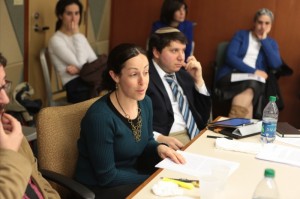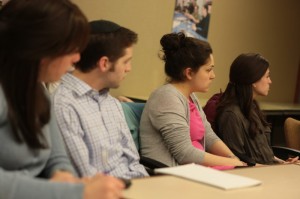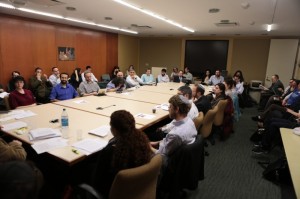May 14, 2013 By: admin
 A team of young scholars that seek to place textual analysis at the forefront of academic halakhah scholarship came to Revel to participate in a symposium on Tuesday evening, April 16th 2013. Around 65 Revel students, alumni, and faculty, as well as other guests, gathered to hear from members of the Graduate Workshop on Jewish Law and Methodology as they presented four papers in a symposium entitled “Interdisciplinary Approaches to Halakhic Texts.”
The panel opened with the keynote by Rachel Furst, PhD candidate in Jewish History at the Hebrew University of Jerusalem and currently Visiting Scholar at the Tikvah Center for Law and Jewish Civilization at NYU Law School. In her remarks, she introduced the aims of the Graduate Workshop, a group of approximately a dozen young scholars that she co-founded in 2009 with Pinchas Roth (a Revel MA graduate in medieval Jewish history, who went on to earn his PhD from the Hebrew University of Jerusalem), who also attended the symposium. Their goal was to discover “narratives of the medieval world and its various social and material realities that can be gleaned from close readings of halakhic sources by applying to them methodologies from a range of disciplines—law, literature, sociology, psychology, communications, and gender studies, among others.” The lectures delivered at this symposium, Furst explained, are “the products of meetings, collaborative readings, and ongoing research among the group over the past four years.”
Ethan Zadoff, PhD candidate in History at the CUNY Graduate Center and Adjunct Professor at Hunter College, delivered his paper on Child Marriage Law in Medieval Ashkenaz in Comparative Perspective. He aimed to show what can be learned about medieval halakhic discussions from a comparison with contemporaneous (Christian) canon law. Zadoff’s case study concerning child marriage in both halakhic and canon law includes the consideration of the “changing dynamic of the medieval family, the relationship between children and parents, and notions of the individual within the context of the family.” Zadoff discussed the following question raised among hakmei ashkenaz (the scholars of the Rhineland yeshivot in the eleventh century): in a case where a father arranges a marriage between his minor son and an adult woman, would the couple require a religious divorce (get) if they decide to terminate their marriage? This matter was debated between the scholars of Mainz and Worms, a
A team of young scholars that seek to place textual analysis at the forefront of academic halakhah scholarship came to Revel to participate in a symposium on Tuesday evening, April 16th 2013. Around 65 Revel students, alumni, and faculty, as well as other guests, gathered to hear from members of the Graduate Workshop on Jewish Law and Methodology as they presented four papers in a symposium entitled “Interdisciplinary Approaches to Halakhic Texts.”
The panel opened with the keynote by Rachel Furst, PhD candidate in Jewish History at the Hebrew University of Jerusalem and currently Visiting Scholar at the Tikvah Center for Law and Jewish Civilization at NYU Law School. In her remarks, she introduced the aims of the Graduate Workshop, a group of approximately a dozen young scholars that she co-founded in 2009 with Pinchas Roth (a Revel MA graduate in medieval Jewish history, who went on to earn his PhD from the Hebrew University of Jerusalem), who also attended the symposium. Their goal was to discover “narratives of the medieval world and its various social and material realities that can be gleaned from close readings of halakhic sources by applying to them methodologies from a range of disciplines—law, literature, sociology, psychology, communications, and gender studies, among others.” The lectures delivered at this symposium, Furst explained, are “the products of meetings, collaborative readings, and ongoing research among the group over the past four years.”
Ethan Zadoff, PhD candidate in History at the CUNY Graduate Center and Adjunct Professor at Hunter College, delivered his paper on Child Marriage Law in Medieval Ashkenaz in Comparative Perspective. He aimed to show what can be learned about medieval halakhic discussions from a comparison with contemporaneous (Christian) canon law. Zadoff’s case study concerning child marriage in both halakhic and canon law includes the consideration of the “changing dynamic of the medieval family, the relationship between children and parents, and notions of the individual within the context of the family.” Zadoff discussed the following question raised among hakmei ashkenaz (the scholars of the Rhineland yeshivot in the eleventh century): in a case where a father arranges a marriage between his minor son and an adult woman, would the couple require a religious divorce (get) if they decide to terminate their marriage? This matter was debated between the scholars of Mainz and Worms, a  question, Zadoff argued, that depended on underlying conceptions of a father’s authority over his minor son. The status of child marriage was also debated among canon lawyers of the time, a debate that likewise reflects differing views of family, parent-child relationships, and the agency of the marital partners. A medieval work known as 74 Titles reflects the Frankish and Carolingian traditions in asserting that marriage is contingent on the consent of the bride’s protective kin. Ivo of Chartres (c. 1040-1115) disagreed, stating that consent of the marital partners is of paramount importance. Thus, Zadoff demonstrated that both medieval Jewish and canon law reflect changing dynamics of the family, conceptions of betrothal, and the authority of parents over minor children.
Jesse Abelman, PhD candidate in medieval Jewish history at Revel, and a faculty member at the Drisha Institute Yesodot program, presented his talk on “Anger, Violence and the Law: Reading Emotion in Medieval Legal Texts.” He compared the ways in which the emotion of anger is given legal weight in medieval halakhic responsa and in the feuding traditions of the eleventh through thirteenth centuries in general (i.e., Christian) European society. He began by citing Stephen D. White’s influential article “The Politics of Anger” to observe that in medieval times the expression of anger was used to justify aristocratic feuding. Abelman argued that Jewish halakhic authorities, on the other hand, cited anger as a legal consideration in order to prevent violence, rather than to condone it. Abelman pointed to the halakhic literature regarding a case of mesirah (the prohibition of informing against a fellow Jew to the Gentile authorities) motivated by anger over a real or perceived affront. Citing the writings of the great Ashkenazic halakhist R. Meir of Rothenberg (c. 1215-1293) and his student R. Hayyim Or Zaru’a (c. 1250-1310), Abelman showed that some halakhic scholars considered such a case to be analogous to the biblical goel ha-dam (blood avenged), who is not punished if he retaliates “in hot anger” against one who killed his kinsman (Deut. 19:6). Among the considerations raised in the halakhic literature was that if mesirah were not permitted under these circumstances, then violence may result instead, as the affronted party might take matters into its own hands rather than seeking legal redress in the Gentile courts.
question, Zadoff argued, that depended on underlying conceptions of a father’s authority over his minor son. The status of child marriage was also debated among canon lawyers of the time, a debate that likewise reflects differing views of family, parent-child relationships, and the agency of the marital partners. A medieval work known as 74 Titles reflects the Frankish and Carolingian traditions in asserting that marriage is contingent on the consent of the bride’s protective kin. Ivo of Chartres (c. 1040-1115) disagreed, stating that consent of the marital partners is of paramount importance. Thus, Zadoff demonstrated that both medieval Jewish and canon law reflect changing dynamics of the family, conceptions of betrothal, and the authority of parents over minor children.
Jesse Abelman, PhD candidate in medieval Jewish history at Revel, and a faculty member at the Drisha Institute Yesodot program, presented his talk on “Anger, Violence and the Law: Reading Emotion in Medieval Legal Texts.” He compared the ways in which the emotion of anger is given legal weight in medieval halakhic responsa and in the feuding traditions of the eleventh through thirteenth centuries in general (i.e., Christian) European society. He began by citing Stephen D. White’s influential article “The Politics of Anger” to observe that in medieval times the expression of anger was used to justify aristocratic feuding. Abelman argued that Jewish halakhic authorities, on the other hand, cited anger as a legal consideration in order to prevent violence, rather than to condone it. Abelman pointed to the halakhic literature regarding a case of mesirah (the prohibition of informing against a fellow Jew to the Gentile authorities) motivated by anger over a real or perceived affront. Citing the writings of the great Ashkenazic halakhist R. Meir of Rothenberg (c. 1215-1293) and his student R. Hayyim Or Zaru’a (c. 1250-1310), Abelman showed that some halakhic scholars considered such a case to be analogous to the biblical goel ha-dam (blood avenged), who is not punished if he retaliates “in hot anger” against one who killed his kinsman (Deut. 19:6). Among the considerations raised in the halakhic literature was that if mesirah were not permitted under these circumstances, then violence may result instead, as the affronted party might take matters into its own hands rather than seeking legal redress in the Gentile courts.
 Sara Tova Brody, MA in Gender Studies at Bar Ilan University and currently a Fellow at Yeshivat Hadar in NY, delivered the third of the evening’s presentations: “Staying Home: Social Standing of Widows in Medieval Spanish Responsa.” Brody introduced the audience to the notion of “feminist geography” and showed how it can illuminate halakhic discussions when we consider “issues such as the boundaries of the home and the divisions between private and public spaces” as defined in halakhic literature. Brody turned her attention to the specific case of “the widow’s lodging,” i.e., a widow’s right to dwell in the husband’s home and claim support from his estate before collecting her ketubah money. Discussing at length a responsum (teshuvah) by R. Solomon ibn Adret (Rashba; Barcelona, 1235-1310), Brody showed that this question is inextricably tied up with a woman’s status inside her own home as well as the way women were viewed by their societies. In other words, while the questions posed to the medieval halakhists in this sort of case relate explicitly to money and estates, the place and status of women at the time emerge quite clearly as key factors.
Following the three presentations, Rachel Furst offered responses to each speaker, and then took questions from the audience—ranging from halakhic to sociological to methodological. A number of attendees remarked that the evening was particularly stimulating. As one Revel alum commented: “The presentations and dialogues were really thought-provoking. These young visiting scholars clearly have a lot to offer and it’s great that Revel organized this symposium. Please do it again!”
Click here to see a photo essay of the event.
This article was written by Steven and Rivka Skaist (Revel 2014)
Sara Tova Brody, MA in Gender Studies at Bar Ilan University and currently a Fellow at Yeshivat Hadar in NY, delivered the third of the evening’s presentations: “Staying Home: Social Standing of Widows in Medieval Spanish Responsa.” Brody introduced the audience to the notion of “feminist geography” and showed how it can illuminate halakhic discussions when we consider “issues such as the boundaries of the home and the divisions between private and public spaces” as defined in halakhic literature. Brody turned her attention to the specific case of “the widow’s lodging,” i.e., a widow’s right to dwell in the husband’s home and claim support from his estate before collecting her ketubah money. Discussing at length a responsum (teshuvah) by R. Solomon ibn Adret (Rashba; Barcelona, 1235-1310), Brody showed that this question is inextricably tied up with a woman’s status inside her own home as well as the way women were viewed by their societies. In other words, while the questions posed to the medieval halakhists in this sort of case relate explicitly to money and estates, the place and status of women at the time emerge quite clearly as key factors.
Following the three presentations, Rachel Furst offered responses to each speaker, and then took questions from the audience—ranging from halakhic to sociological to methodological. A number of attendees remarked that the evening was particularly stimulating. As one Revel alum commented: “The presentations and dialogues were really thought-provoking. These young visiting scholars clearly have a lot to offer and it’s great that Revel organized this symposium. Please do it again!”
Click here to see a photo essay of the event.
This article was written by Steven and Rivka Skaist (Revel 2014)